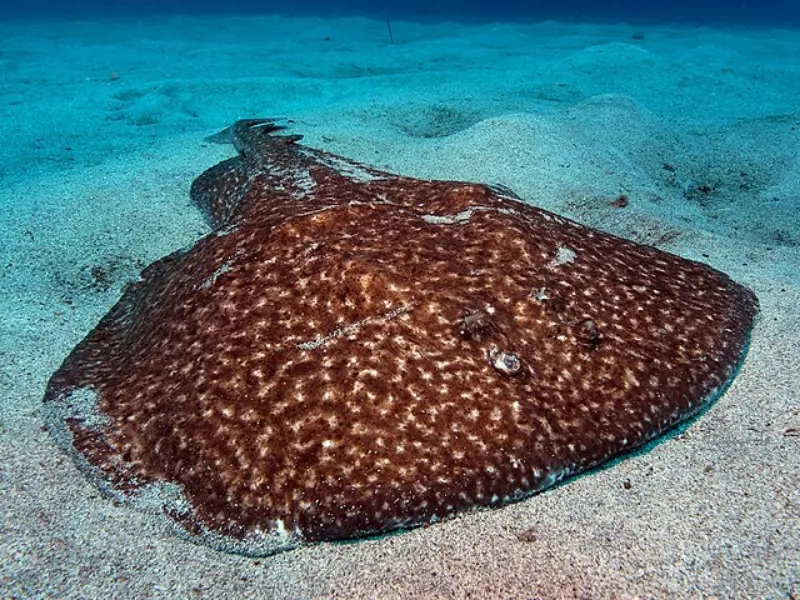Have you ever imagined an animal that could generate electricity? Meet the electric ray! These fascinating creatures possess a unique adaptation that allows them to produce an electrical discharge. This article will delve into the world of electric rays, exploring their characteristics, habitats, and the science behind their amazing ability.
What are Electric Rays?
Electric rays are a group of rays belonging to the order Torpediniformes. They are characterized by their ability to generate an electrical discharge from specialized organs located in their pectoral fins. These organs can produce a powerful shock used for defense, hunting, and even communication. There are roughly 69 different species of electric rays, categorized into various families.

Key Characteristics of Electric Rays
- Electric Organs: These are the most defining feature, capable of generating significant electrical discharges.
- Flattened Body Shape: Like other rays, they have a flattened body well-suited for life on the seabed.
- Cartilaginous Skeleton: Their skeleton is made of cartilage, similar to sharks.
- Rounded Disc: Most species have a rounded or oval-shaped disc formed by their pectoral fins.
- Small Eyes: Compared to other rays, their eyes are relatively small.
Where Do Electric Rays Live? (Habitat and Distribution)
Electric rays inhabit a wide range of marine environments across the globe. They can be found in:
- Tropical and Temperate Waters: They thrive in both tropical and temperate climates.
- Shallow Coastal Areas: Many species prefer shallow waters near the coast.
- Deep Sea: Some species are adapted to the extreme pressures and darkness of the deep sea.
- Atlantic, Pacific, and Indian Oceans: They are distributed throughout major oceanic regions.
- Mediterranean Sea: Several species can be found in the Mediterranean.
Their adaptability allows them to occupy diverse niches within the marine ecosystem. The specific habitat preferences vary depending on the species.
The Science Behind the Shock: How Electric Rays Generate Electricity
The electrical discharge of electric rays is generated by specialized organs called electric organs. These organs are composed of modified muscle or nerve cells known as electrocytes.
Understanding Electrocytes
Electrocytes are arranged in columns, resembling a battery. Each electrocyte produces a small voltage, but when thousands of electrocytes are stimulated simultaneously, the combined voltage can be substantial.
The Process of Electrical Discharge
- Nerve Stimulation: A signal from the ray’s nervous system triggers the electrocytes.
- Ion Flow: This stimulation causes a flow of ions across the electrocyte membranes.
- Voltage Generation: Each electrocyte generates a small voltage difference.
- Combined Effect: The voltages of all the electrocytes in the column add up, producing a powerful electrical discharge.
The strength of the shock varies depending on the species and the size of the ray. Some species can produce discharges of up to 200 volts, enough to stun prey or deter predators.
What Do Electric Rays Eat? (Diet and Hunting)
Electric rays are primarily carnivores, feeding on a variety of marine animals. Their diet depends on the species and the size of the ray.
Common Prey Items
- Fish: Small fish are a staple food source.
- Crustaceans: Crabs, shrimp, and other crustaceans are also consumed.
- Invertebrates: Various invertebrates living on the seabed are part of their diet.
Hunting Strategies
Electric rays use their electrical discharge to stun or kill prey. They typically ambush their prey, lying in wait on the seabed. When prey comes within range, they unleash an electrical shock to immobilize it. Once stunned, the electric ray can easily capture and consume its prey.
Electric Rays: Defense Mechanisms and Predators
The electrical discharge of electric rays serves not only as a hunting tool but also as a powerful defense mechanism. It helps them to deter predators and avoid being eaten.
Defense Against Predators
When threatened, an electric ray can deliver an electrical shock to potential predators. This can be enough to discourage the predator from attacking. The shock can be painful and disorienting, giving the ray time to escape.
Natural Predators
Despite their electrical defenses, electric rays are still vulnerable to predation by larger marine animals, including:
- Sharks: Large sharks are known to prey on electric rays.
- Other Large Fish: Some large bony fish may also prey on them.
The camouflage provided by their flattened body shape also helps them to avoid detection by predators.
Reproduction and Life Cycle of Electric Rays
The reproductive strategies of electric rays vary depending on the species. They typically reproduce via two main methods:
Ovoviviparity
Most electric rays are ovoviviparous. This means that the eggs develop inside the mother’s body, and the young are born live. The embryos are nourished by a yolk sac during development.
Oviparity
A few species of electric rays are oviparous, meaning they lay eggs in leathery egg cases on the seabed. The embryos develop inside the egg case, and eventually hatch into small electric rays.
Life Cycle
The life cycle of electric rays is relatively slow. They typically reach sexual maturity after several years. Their lifespan can vary depending on the species, but some electric rays can live for over a decade.
Conservation Status and Threats to Electric Rays
The conservation status of electric rays varies depending on the species. Some species are considered to be of least concern, while others are threatened or endangered.
Threats to Electric Rays
- Overfishing: Some electric ray species are caught as bycatch in commercial fisheries.
- Habitat Destruction: Destruction of their habitat due to coastal development and pollution can also threaten electric ray populations.
- Climate Change: Changes in ocean temperature and acidity can affect their distribution and survival.
Conservation Efforts
Conservation efforts are needed to protect electric ray populations. These efforts include:
- Sustainable Fishing Practices: Implementing sustainable fishing practices to reduce bycatch.
- Habitat Protection: Protecting and restoring their habitats.
- Monitoring Populations: Monitoring electric ray populations to assess their status and trends.
- Education and Awareness: Raising awareness about the importance of electric ray conservation.
Electric Rays in Culture and History
Electric rays have been known to humans for centuries. Ancient civilizations recognized their ability to generate electricity and used them for medicinal purposes.
Historical Uses
In ancient Greece and Rome, electric rays were used to treat ailments such as headaches and gout. The electrical shock was believed to have therapeutic properties.
Modern Understanding
Today, scientists have a much better understanding of the biology and electrical capabilities of electric rays. Their unique adaptations continue to fascinate researchers and inspire new technologies.
Fun Facts About Electric Rays
- Some electric rays can control the voltage of their electrical discharge.
- The electric organs can make up a significant portion of the ray’s body weight.
- Baby electric rays can generate electricity soon after birth.
- Electric rays have sensory receptors that allow them to detect electrical fields produced by other animals.
Conclusion: Appreciating the Electrifying Electric Ray
Electric rays are truly remarkable creatures with a unique adaptation that sets them apart from other marine animals. Their ability to generate electricity has fascinated humans for centuries and continues to inspire scientific research. By understanding their biology, behavior, and conservation needs, we can help ensure that these amazing animals continue to thrive in our oceans for generations to come.
Let’s work together to protect these electrifying inhabitants of our oceans and appreciate the amazing diversity of life that exists beneath the waves!




